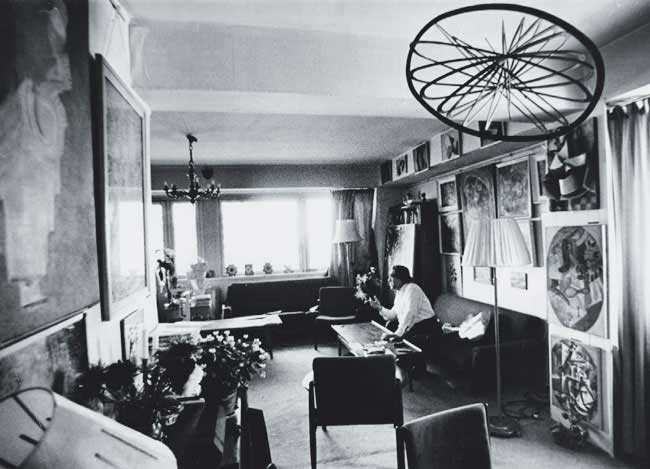- (Russian) Biography
- (Russian) 1997 Exhibition
.

Georgy Costakis by Anatoly Zverev, end of 50ies
In the years around the 1917 Revolution, Russia produced the first non-figurative art movement which was to be the defining art of the 20th century. George Costakis (Russian: Георгий Дионисович Костаки, 1913-1990) rediscovered the Russian constructivist paintings in a Moscow studio in 1946, which began his large collection of Russian abstract art.
This collection was to become the most representative body of Modern Russian avant-garde art anywhere in the world at that time.

George Costakis
Family History
Born in Moscow of affluent Greek parents George Costakis had no artistic education but developed an interest in art during his adolescence and as soon as he was able to, he began buying art. At first he worked as a driver for the Greek Embassy until 1940 then as Head of Personel for the Canadian Embassy.
His work at the Canadian Embassy brought him into contact with many visiting diplomats and he would show them around the Moscow art galleries and antique shops.
The Russian Revolution and Art
From the 1860s an art-buying middle class in Moscow had ensured an interest in and a market for Impressionist, Symbolist and Art Nouveau works produced in Russia and the rest of Europe. 'Culture' and collecting paintings had been a long established essential for the wealthy citizen of Moscow (Gray). In the early years of the 20th century the cultural and politial climate of Europe as a whole was in a state of change with a cross-fertilisation of ideas across national boundaries. Many French cubist and Italian futurist works were being brought into Russia and exhibited.
Stalinism
At first the Bolshevik Revolution under the leadership of Lenin supported the new abstract art but from 1920 onwards the freedom of artists in Russia was increasingly curtailed. Many artists wanted their work to contribute to the creation of a new society whilst others, for example the Suprematists continued to work independantly.
Lenin died in 1924 and Stalin who succeeded him as leader of the Soviet Communist Party, brought about an extreme form of totalitarism . In 1932 socialist realism became the official state policy. It was within this political environment that Costakis experienced the creation, development, supression and final disintegration of culture in Russia.
The Costakis Collection
At first Costakis had collected the Masters of the Dutch School of Landscape Painters but modernist works by Piccasso and Matisse soon became his main subject, then in 1946 he came across three paintings in a Moscow studio by Olga Rozanova . He described how, in the dark days after the war these brightly coloured paintings of the lost Avant-Garde:
were signals to me. I did not care what it was... but nobody knew what anything was in those days. (Chatwin, 1977)
He was so struck by the powerful visual effect of the strong colour and simple design that he was determined to rediscover the Suprematist and Constructivist art which had been lost and forgotten in the attics, studios and basements of Moscow and Leningrad.
He hunted for 'lost' pictures, some that were rolled up and covered with dust. He met Vladimir Tatlin and befriended Varvara Stepanova. He tracked down friends of Kasimir Malevich and bought works by Liubov Popova and Ivan Kliun.
By the 1960 the appartment of George Costakis in Moscow had become a meeting place for international art collectors and art lovers in general: Russia's unofficial Museum of Modern Art. The 'détante' period following the signing of the Paris Peace Accords in 1973 opened up Russia once again to international cultural exchanges the first of which was the showing of the Costakis Collection in Dusseldorf in 1977.
The same year Costakis, with his family, left the Soviet Union, but there was an agreement that he should leave 80 per cent of his collection in the State Tretyakov Gallery of Moscow. Recently (1997?) the 1275 works of art have been re-housed in the State Museum of Contemporary Art, Thessaloniki, Greece.
Exhibitions of the Costakis Collection
- 1977 Costakis Collection, Dusseldorf, Deutsche Bank
- 1981 Art of the Avant-Garde in Russia, Guggenheim
- 1992 The Great Utopia: Soviet Avant-Garde 1915-1932
- 1995 Berlin-Moscow/Moscow-Berlin exhibition, supported by Deutsche Bank
- 1997 Russian Avant-Garde from the Collection of G.D. Costakis, Tretyakov Gallery
- 2000 Amazons of the Avant-Garde, Guggenheim travelling exhibition: Berlin, London, Venice, Bilbao.
Links
References
- John Bowlt and Matthew Drutt, Amazons of the Avant-Garde, Guggenheim Museum, 2000
- Bruce Chatwin, Moscows Unofficial Art, Sunday Times, 6 May 1973
- Mel Gooding, Abstract Art, Movements in Modern Art Series, Tate Publishing, 2000
- Camilla Gray, The Russian Experiment in Art 1863-1922, Thames and Hudson, 1976
- Peter Roberts, George Costakis: A Russian Life in Art, Carlton University Press, 1994
| Ancient Greece
Science, Technology , Medicine , Warfare, , Biographies , Life , Cities/Places/Maps , Arts , Literature , Philosophy ,Olympics, Mythology , History , Images Medieval Greece / Byzantine Empire Science, Technology, Arts, , Warfare , Literature, Biographies, Icons, History Modern Greece Cities, Islands, Regions, Fauna/Flora ,Biographies , History , Warfare, Science/Technology, Literature, Music , Arts , Film/Actors , Sport , Fashion --- |
Retrieved from "http://en.wikipedia.org"
All text is available under the terms of the GNU Free Documentation License

